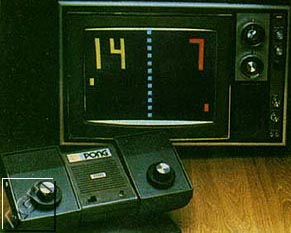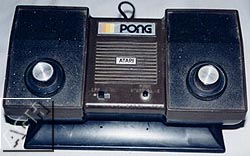ATARI HOME PONG -

|
Atari's first commercial coin-operated success also became the
company's initial entry into the home video game sweepstakes.
With arcade Pong proving to be a smash hit in the arcades,
allowing eager players to enjoy the game in the comfort in their
own homes was a logical extension. And by 1974, the cost of
microchips had decreased dramatically and one designer at Atari,
Bob Brown, had aspirations of bringing Pong to the home.
Atari's management balked at the idea, since the company had
no experience in the distribution of consumer electronics
products and did not want its cash flow to be severely tied in
a risky product. Still, Bushnell thought that Pong for the
home was a good idea and gave Brown the green light to develop
it. Brown began work on Pong in the fall of 1974 and completed
it shortly thereafter.
Pong was not the first console to be sold in stores, however. That distinction belongs to Magnavox's Odyssey machine (created by Ralph Baer), which debuted in 1972. However, that machine proved too costly, and the poor marketing by Magnavox as well as confusion of whether it was playable on televisions other than ones made by Magnavox led to its doom.
 Unlike its arcade cousin, the home version of Pong displayed color images on the television screen, and two players could enjoy the game (in fact, it was a two-player-only game). There was a paddle attached on the left and right side of the machine; no detachable controllers here. The best part of Home Pong, however, was the price. Because chips by then were so inexpensive compared to even a year before, Pong cost less than Odyssey did. Pong also played a role in the beginning of the Atari-Sears relationship. In January of 1975, a representative at Sears showed up at Atari and offered to buy all the Pongs the company could put together. When Bushnell informed the buyer that they could manufacture 75,000 units, the representative told him to double the production and Sears would take care of the financing. Sears, in turn, wanted to have the exclusive selling rights of the game throughout 1975. Bushnell found the offer impossible to resist, especially since Sears promised to pay all of the advertising and take complete control of the distribution. There was very little risk for Atari. It gave the company exposure in over 900 stores across the country and would give them name recognition in home games as well as arcade. Thanks to the Sears deal, Atari sold $40 million worth of Pongs in 1975 and made a profit of $3 million. ------------------------------------------------- For more in-depth information on both Pong and the history of videogames, check out the book "Phoenix: The Fall and Rise of Home Videogames" by Leonard Herman (Rolenta Press, 1994), pp. 53, 74-75.
For information on how to order this fine book, contact |
